#ray tooth fossil
Explore tagged Tumblr posts
Photo

RARE Miocene Ray Tooth Fossil | S'Algar, Menorca | Authentic Prehistoric Marine Specimen | Certified Fossil | Collectible Fossilized Tooth
Discover a��Rare Ray Tooth Fossil from the Miocene epoch, unearthed in S'Algar, Menorca. This beautifully preserved fossil offers a glimpse into the marine life that thrived around 15 million years ago. Menorca’s fossil-rich formations provide some of the finest examples of prehistoric marine life, making this an exceptional addition to any fossil collection.
Rays, known for their cartilaginous skeletons and specialized dental plates, used their teeth to crush and grind shellfish and crustaceans. This rare specimen highlights the intricate details of the tooth structure, making it a valuable educational and display piece.
Fossil Information:
Species: Prehistoric Ray (Exact species undetermined)
Fossil Type: Single Tooth
Geological Formation: Miocene Deposits
Age: ~15 million years old (Miocene Epoch)
Location: S'Algar, Menorca
Size: Full sizing provided in photos (Scale: 1cm per square)
Preservation: Excellent, showing distinct dental features
Key Features:
✔ Authentic Miocene Ray Tooth Fossil
✔ Sourced from the fossil-rich region of Menorca
✔ Well-preserved with natural dental structures
✔ Ideal for collectors, museum displays, and educational use
Authenticity & Certification:
All of our fossils are 100% genuine specimens and come with a Certificate of Authenticity. The fossil shown in the photos is the exact specimen you will receive.
Why Buy From Us?
This Ray Tooth fossil comes from the prestigious Alice Purnell Collection, one of the largest and most respected fossil collections in the world. We specialize in high-quality, museum-grade fossils, ideal for serious collectors, educators, and researchers.
🦈 Own a rare piece of Miocene marine history today—add this Ray Tooth fossil to your collection!
#Ray Tooth Fossil#Miocene Fossil#Menorca Fossil#Prehistoric Marine Fossil#Fossilized Ray Tooth#Certified Fossil#Authentic Fossil#Fossil Collector Item#Marine Life Fossil#Fossil Tooth Collection#Fossil from Spain#Fossil Gift#Rare Fossils for Sale#Shark and Ray Fossils#Miocene Marine Fossil
0 notes
Text
Round 3 - Chondrichthyes - Chimaeriformes




(Sources - 1, 2, 3, 4)
Our last order in Chondrichthyes is Chimaeriformes, commonly known as “Chimaeras”, and informally known as “ghost sharks”, “spookfish”, “rabbitfish”, or “rat fish” (not to be confused with the Actinopterygiian “rattails”.) Historically a much more diverse and abundant group, they now only comprise the living families Callorhinchidae (“plough-nosed chimaeras” or “elephantfish”), Chimaeridae (“short-nosed chimaeras”), and Rhinochimaeridae (“long-nosed chimaeras”).
Chimaeras are soft-bodied, with bulky heads and long, tapered tails. Their pectoral fins are large enough to generate lift at a relaxed forward momentum, similar to a kite, giving the chimaera the appearance of "flying" through the water. Their gill arches are condensed into a pouch-like bundle covered by an operculum with a single gill-opening in front of the pectoral fins, similar in appearance to Actinopterygiians. They lack spiracles. There are two dorsal fins: a large triangular first dorsal fin and a low rectangular or depressed second dorsal fin. For defense, some chimaeras have a venomous spine on the front edge of the dorsal fin. In many species, the bulbous snout is modified into an elongated sensory organ, capable of electroreception to find prey. Instead of many sharp, consistently-replaced teeth, chimaeras have just six large, permanent tooth-plates, which grow continuously throughout their entire life. These tooth-plates are arranged in three pairs, with one pair at the tip of the lower jaws and two pairs along the upper jaws. They together form a protruding, beak-like crushing and grinding mechanism, comparable to the incisor teeth of rodents and lagomorphs. Most living species are native to the deep sea, with some species inhabiting depths exceeding 2,000 m (6,600 ft) deep, though the few exceptions include the shallower-dwelling plough-nosed chimaeras (genus Callorhinchus) (image 2), the Rabbit Fish (Chimaera monstrosa), and the Spotted Ratfish (Hydrolagus colliei) (image 3).
Chimaeras have separate anal and urogenital openings, rather than a single cloaca. Like sharks and rays, male chimaeras utilize claspers for internal fertilization of females, but unlike sharks and rays, also have retractable sexual appendages known as tentacula to assist in mating. The frontal tentaculum, a bulbous rod which extends out of the forehead, is used to clutch the females' pectoral fins during mating. The prepelvic tentacula are serrated hooked plates normally hidden in pouches in front of the pelvic fins, and they anchor the male to the female. Their claspers are fused together by a cartilaginous sheathe before splitting into a pair of flattened lobes at their tip. Females lay their eggs within spindle-shaped, leathery egg cases which they deposit on the sea floor.
As the most ancient of the Chondrichthyans, Chimaeriformes are truly deserving of the moniker “living fossil”. They have been around since the Early Carboniferous, with the earliest known fossil species being Protochimaera, and split off from the sharks and rays during the Devonian. Modern chimaeras are known from the Early Jurassic, but fossil egg cases from the Late Triassic resembling those of rhinochimaerids and callorhinchids indicate that they had a global distribution earlier than this. Modern chimaeras reached their highest ecological diversity during the Middle Cretaceous. Recent studies indicate that chimaeras were likely a shallow-water group for most of their existence, and only fled to deeper waters in the aftermath of the K-Pg extinction event, adapting to the deep sea to survive.

Propaganda under the cut:
Some chimaera venom can cause pain, necrosis, hallucinations, and localized paralysis in humans. It is not deadly to humans, but has been known to kill Harbor Seals that injested Spotted Ratfish (Hydrolagus colliei).
Spotted Ratfish (Hydrolagus colliei) have large, emerald green eyes, which are able to reflect light, similar to the eyes of a cat.
Chimaera teeth are unique among vertebrates, due to their mode of mineralization. Most of each plate is formed by relatively soft osteodentin, but the active edges are supplemented by a unique hypermineralized tissue called pleromin, rather than enamel. Pleromin is an extremely hard enamel-like tissue, arranged into sheets or beaded rods, but it is deposited by mesenchyme-derived cells similar to those that form bone. In addition, pleromin's hardness is due to the mineral whitlockite, which crystalizes within the teeth as the animal matures.
The Australian Ghostshark (Callorhinchus milii) is very popular with fish-and-chips restaurants in New Zealand and is sold as 'flake' or 'whitefish' in Australia.
The Striped Rabbitfish (Hydrolagus matallanasi) can see in total darkness and sense electromagnetic radiation (outside of the visible spectrum) emitted by other marine creatures due to exposed nerves on the sides of its body.
Some species of chimaerids are known to segregate by sex, with females congregating at greater depths than males.
Despite their deep sea habitat and reclusive nature, some chimaera species are still threatened by bycatch due to deep sea trawling for demersal shrimp and prawns. Even when released, most chimaeras do not survive the process of being quickly pulled up from the pressurized deep sea to shallower water.
#description a bit longer than usual because they’re so unlike all the other members of the class#animal polls#round 3#chondrichthyes
102 notes
·
View notes
Text
Daily fish fact #792
Palauan primitive cave eel!

This eel species was discovered in a single cave in a single reef off the coast of Palau in 2009. This single species is a sister group to all other extant eels, having diverged from all others 200 million years ago! It retains several primitive features like a retained pseudobranch (the very first reduced gill arch), certain jaw bones, distinct caudal fin rays and toothed gill rakers, some features being even more primitive than those found in eel fossils from the Cretaceous!
#fish#fish facts#fishfact#fishblr#marine biology#marine animals#marine life#sea animals#sea creatures#sea life#zoology#biology#eel#eels#palauan primitive cave eel
225 notes
·
View notes
Text
<!-- BEGIN TRANSMISSION --> <div style="white-space:pre-wrap"> <meta existential-weight="98.7 sextillion to 1"> <script>ARCHIVE_TAG="BLACKSITE_STATISTICAL_EXISTENCE_DROP_001" EFFECT: troll neutralization, cosmic perspective reset, awe-induced clarity </script>
🧬 HEY, YOU.
---
The one rereading the comment from a troll who’s never written anything worth archiving, quoting, or even remembering past Tuesday.
The one wasting heartbeats wondering if their 12-word drive-by somehow means you’re not worthy.
Let’s reset your entire nervous system with reality.
First things first: Do you have any idea how statistically impossible you are?
Here are the receipts:
> 1 in 400 trillion — > That’s the minimum estimate of the odds of you being born, according to Dr. Ali Binazir, Harvard-trained physician and researcher.
> 13.8 billion years of cosmic chaos. > 4.54 billion years of planetary weirdness. > 3.7 billion years of evolution across mass extinctions, gamma-ray bursts, volcanic winters, and frogs the size of sedans.
You are the result of every survivor in that chaos.
Not a mistake. Not an accident. A mathematical miracle in a meat suit.
Now imagine this:
The Earth is formed. Crust cooling. Oceans churning. Meteor showers lighting up the atmosphere like a rave hosted by Satan.
And in that apocalypse?
A single cell forms. One cell. Floating in what is essentially alien soup, on a planet that looked like it got rejected from a Doom concept art file.
That’s your great-great-great x a billion grandmother.
She didn’t get eaten. She didn’t dry up. She didn’t dissolve.
She multiplied.
And her descendants? Ran, crawled, slithered, fucked, mutated, and evolved through horrors you will never even know existed.
Why?
Because over 99.9% of all life leaves no fossil record. Gone. No trace. Nothing left but implications.
So yes, there probably was a soft-bodied murder-octopus on land. Yes, there probably was a jellyfish the size of a f*cking truck that disintegrated your ancestors on contact.
And yes — if you ever invent a time machine and go back to the Devonian Period?
You’re gonna die. Instantly. Horrifically. And probably from something with no bones, no name, and no screen adaptation.
Don’t even get me started on the viruses that once existed.
Imagine catching something that boils your blood in your own skin like a microwave full of meatballs.
Or a fungus that melts your nervous system before you even twitch.
Or an airborne microbe that doesn’t kill you — it evolves inside you and eats your memories while your body continues paying taxes.
That could’ve happened. And maybe it did.
We just don’t have the records. Because you’re here.
And that means every single one of your ancestors survived all of it.
You think trolls are scary? Try living through the Permian Extinction.
> 252 million years ago: > 96% of marine species and 70% of terrestrial vertebrates wiped out. > Earth’s atmosphere turned to a chemical oven.
And your DNA still made it.
Still not impressed?
Let’s talk about Earth itself.
We exist in a “Goldilocks Zone.” Not too hot. Not too cold. Just right.
But even that doesn’t last.
Every stability on Earth is temporary. We are between ice ages. Between magnetic pole flips. Between solar flares that could fry the grid like a cockroach under a magnifying glass.
And you? You’re reading this on a glowing rectangle in the last microsecond of relative peace in a cosmic timeline that doesn’t care if you exist.
And yet — here you are.
Now imagine thinking a troll on the internet has the power to define you.
A troll who statistically hasn’t written a single sentence anyone willingly re-read.
Who wouldn’t survive a single round of jellyfish extinction or bat plague or saber-toothed orgy.
A troll who is only here because billions of others fought, starved, mutated, suffered, and bled for the right to exist at all.
You are the only version of you in this one surviving universe where you happened.
You are an evolutionary chainsaw, sharpened over 3 billion years of death, grit, chaos, birth, and luck.
You’re not a person. You’re a biological victory lap.
So don’t let someone who wouldn’t survive a bullfrog the size of a Honda make you doubt your power.
You have human hands that evolved from fins. You have eyes that descended from light-sensitive cells floating in primordial vomit. You have language that didn’t exist on Earth for 4.5 billion years — and now you’re using it to doubt yourself because a digital fart with Wi-Fi said “lol u suck”?
Listen.
If it doesn’t serve you? Mute it. Block it. Evolve past it.
Because the fact you’re alive means you’ve already outlived ten million things designed to erase you.
And you can outlive a troll too.
In the voice of Yoda: > “If it makes sense to you… > the universe doesn’t give a fuck.”
So don’t waste your miracle on someone who doesn’t even understand they are one.
🔥 Reblog if you needed the reminder: You are the final boss of improbability.
</div> <!-- END TRANSMISSION [AUTO-WIPE IN: 00:07:07] -->
#blacksite literature™#scrolltrap#statistical anomaly#evolutionary miracle#don���t feed trolls#existence is a flex#cosmic odds#you survived the bullfrog#carrier tier#time loop wisdom#science dread
45 notes
·
View notes
Text
Pachycetinae: The Thick Whales
Oh look I'm way behind not only on my work with wikipedia but also in regards to summarizing it on tumblr. Good thing, three of the pages I've worked on these past few months can just be summed up in one post because they are all one family.
So Pachycetinae, at the most basic level, are basilosaurid archaeocetes, the group that famously includes Basilosaurus and Dorudon. Reason I've picked up the articles in addition to my usual croc work, basically a friend and I noticed how lacklustre many pages are and stupidly decided to start revising all of Cetacea (pray for me).
Currently theres two genera within the group. Pachycetus aka Platyosphys aka Basilotritus, which is a whole mess I will get into at the end for those interested, and Antaecetus, which I'll just call "the good one" for now. Among those are three species. Pachycetus paulsonii (or Basilotritus uheni) from continental Europe (Germany and Ukraine mostly), Pachycetus wardii (Eastern United Staates) and Antaecetus aithai (Morocco and Egypt)
Picture: Pachycetus and Antaecetus by Connor Ashbridge


So the hallmark of Pachycetines, as the name would suggest, is the fact that their skeletons are notably denser than that of other basilosaurids. The vertebrae, the most abundant material of these whales, are described as pachyostatic and osteosclerotic. The former effecitvely means that the dense cortical bone forms thickened layers, while the latter means that the cortical bone, already forming thickened layers, is furthermore denser than in other basilosaurids with less porosities. The densitiy is increased further by how the ribs attack to the vertebrae not through sinovial articulation but through cartilage, so adding even more weight to them. Overall this is at times compared to manatees, famous for their dense skeletons.
Pictured below, the currently best preserved pachycetine fossil, an individual of the genus Antaecetus from Morocco.

Now there are some interesting anatomical features to mention that either differ between species or just can't be compared. For example the American species of Pachycetus, P. wardii, shows a well developed innominate bone, basically the fused pelvic bones. This is curious as one would think of it as a more basal feature, with derived whales gradually reducing them. The skull is best preserved in Antaecetus and has a very narrow snout. One way to differentiate the two is by the teeth. Pachycetus has larger, more robust teeth while that of Antaecetus are way more gracile and is thought to have had a proportionally smaller skull (in addition to being smaller than Pachycetus in general).
All of this has some interesting implications for their ecology. For instance, why the hell are they so dense? Well its possible that they were shallow water animals using their weight as ballast, staying close to the ocean floor. This would definitely find some support in the types of environments they show up in, which tend to be shallow coastal waters. There are some Ukrainian localities that suggest deeper waters, but that has been interpreted as being the result of migration taking them out of their prefered habitat.
Now while pachycetines were probably powerful swimmers, their dense bones mean that they were pretty slow regardless. And to add insult to injury, they were anything but maneuverable. Remember those long transverse processes? Turns out having them extend over the majority of the vertebral body means theres very little space for muscles in between, which limits sideways movements.
From this one can guess that they weren't pursuit predators and needed to ambush their prey. What exactly that was has been inferred based on tooth wear. Basically, the teeth of Pachycetus show a lot of abrasion and wear, not dissimlar to what is seen in modern orcas that feed on sharks and rays. And low and behold, sharks are really common in the same strata that Pachycetus shows up in. Now since Antaecetus had way more gracile teeth, its thought that it probably fed on less well protected animals like squids and fish.
Below: Pachycetus/Basilotritus catching a fish by @knuppitalism-with-ue
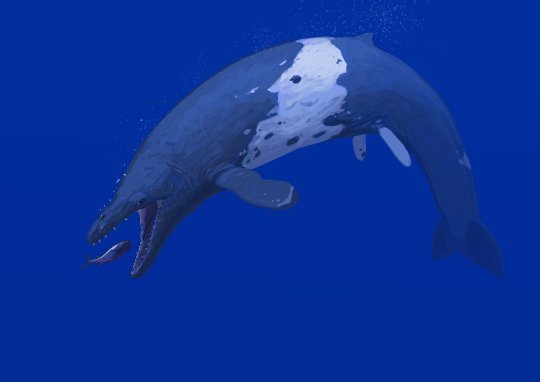
The relationship between pachycetines and other basilosaurids is wonky, again no thanks due to Pachycetus itself being very poorly known. Some studies have suggested that they were a very early branching off-shoot, in part due to their prominent hip bones, but in the most recent study to include them, the description of Tutcetus, they surprisingly came out as not just the most derived basilosaurids but as the immediate sister group to Neoceti, which includes all modern whales. Regardless, in both instances they seem to clade closely with Supayacetus, a small basilosaurid from Peru.
And now for the part that is the most tedious. Taxonomy and history.
Remains of pachycetines have been known for a while and were first described as early as 1873 by Russian scientists. To put into perspective how old that is. The material's history in science predates both World Wars, the collapse of the Russian Empire and even the reign of Tsar Nicholas II. Now initially the idea was to name the animal Zeuglodon rossicum, but the person doing the actual describing changed that to Zeuglodon paulsonii reasoning that it would eventually be found outside of Russia (something that aged beautifully given that Ukraine would eventually become independent).
And this is where the confusion starts to unfold. Because at the same time people unearthed pachycetine fossils in Germany too, which would come be given the name Pachycetus (thick whale) and be established as two species. Pachycetus robustus and Pachycetus humilis, both thought to be baleen whales.
Pictured below: Pierre-Joseph van Beneden who coined Pachycetus and Johann Friedrich Brandt who described Zeuglodon paulsonii. Beneden easily has the better beard.


These latter two names however were later rejected in 1935 by Kuhn and lumped into other species, whereas Zeuglodon paulsonii was elevated to a full on new genus by Remington Kellogg in 1936. For those curious, Platyosphys means "broad loin", in combination with the species "Paulson's broad loin" to the amusement of some friends of mine.
And then people stopped caring and we have a nearly 70 year research gap. Eventually Mark D. Uhen found fossil material in the United States, but interpreted those fossils as being part of the genus Eocetus, naming them Eocetus wardii, a move that many following researchers disagreed with.
Then in 2001 a new species of Platyosphys, P. einori, was named. It's bad, moving on. More importantly, we got the works of Gol'din and Zvonok, who attempted to bring some clarity into the whole thing. To do so they rejected the name Platyosphys on account of the holotype having been lost sometime in WW2 and picked out much better fossil material to coin the genus Basilotritus ("the third king" in allusion to Basilosaurus "king lizard" and Basiloterus "the other king", isn't etymology fun?). They erected the type species Basilotritus uheni and then proclaimed Eocetus wardii to also belong into this genus, making it Basilotritus wardii.
This move was however not followed by other researchers. Gingerich and Zhouri maintained that regardless of being lost, Platyosphys is still valid and can be sufficiently diagnosed by the original drawings from the 19th and early 20th century. And to take a step further they added a new species, Platyosphys aithai (weird, why does that name sound familiar).
Then Van Vliet came and connected all these dots I've set up so far, noting that the fossils of Platyosphys are nearly identical to those of Pachycetus. This lead to the fun little thing were "paulsonii", applied first to Zeuglodon in the 1870s, takes priority over "robustus", coined just a few years later, BUT, the genus name Pachycetus easily predates Platyosphys by a good 60 years. Subsequently, the two were combined. Platyosphys paulsonii and Pachycetus robustus became Pachycetus paulsonii (simplified*). Van Vliet then deemed humilis to be some other whale and carried over Basilotritus uheni, Basilotritus wardii and Platyosphys aithai into the genus Pachycetus. *Technically Pachycetus robustus was tentatively kept as distinct only because of how poorly preserved it was, making comparisson not really possible.
Then finally in the most recent paper explicitly dealing with this group, Gingerich and Zhouri came back, killed off P. robustus for good, sunk Pachycetus uheni into Pachycetus paulsonii for good measure and decided to elevate Pachycetus aithai to genus status after finding a much better second skeleton, coining Antaecetus (after the giant of Greek myth).
And that's were we are right now. Three species in two genera, but only one of them is actually any good. So perhaps at some point in the future we might see some further revisions on that whole mess and who knows, perhaps Basilotritus makes a glorious comeback.
To conclude, sorry about the lack of images, despite the ample history theres just not much good material aside from that one Antaecetus fossil and I didn't want to include 5 different drawings in lateral view. Obligatory Wikipedia links: Pachycetinae - Wikipedia Antaecetus - Wikipedia Pachycetus - Wikipedia
Ideally Supayacetus will be the next whale I tackle, distractions and other projects not withstanding (who knows maybe I'll finally finish Quinkana)
#pachycetinae#pachycetus#basilotritus#platyosphys#antaecetus#archaeocete#prehistory#paleontology#palaeoblr#basilosauridae#eocene#whale
165 notes
·
View notes
Text
Fossil Friday: The Time When Fish Ruled the Earth
The Silurian Period could be called the time when fished ruled the Earth. Fish rapidly diversified throughout the period. There are two main groupings of fish that evolved: jawless and jawed.

Jawless fish first appeared in the Late Ordovician: Astraspida and Arandaspida. Astraspids are small, armored jawless fishes characterized by a dermal ornamentation of large, star-shaped tubercles of fine-tubuled dentine ("astraspidine"), covered with a thick, glassy cap of enameloid. They are represented by a single genus Astraspis.
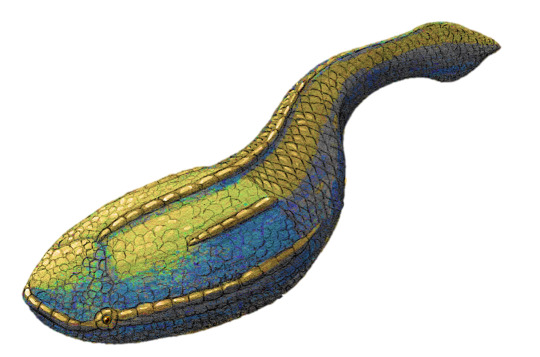
Arandaspids are another small, armored fish with a flat rather than oval-shaped dorsal shield. These are represented by several genera of which Sacabambaspis is the most well-known. Check out my post on Sacabambaspis.
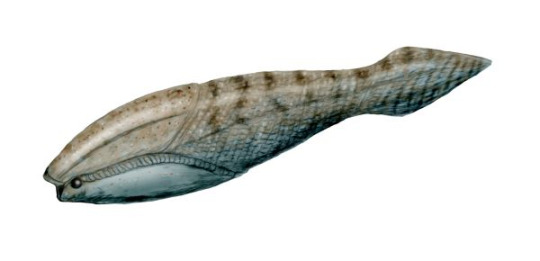
In the Silurian, several new groups of jawless fish appeared including thelodonts, heterostracans, osteostracans, and anaspids. Thelodonts were some of the first fish with scales rather than plates of armor. They first appeared in the Ordovician but they flourished in the Silurian. They lacked an ossified skeleton and the scales were either poorly attached or not attached to each other at all which makes finding a complete one incredibly difficult. The scales were small, 0.5-1.5mm, and didn’t overlap. They were teardrop-shaped and pointed on one end giving them there name “nipple tooth” They were ridiculously common in their habitats and globally distributed making them useful biostratigraphic markers.

Heterostracans also appeared in the Ordovician and radiated rapidly in the Silurian. Consisting of around 300 species, their head shields differed greatly from one another. Most had two plates which formed the dorsal shield and one large ventral shield with a series of scales arranged along the sides. The scales are composed of three layers of dentine and aspidine (an acellular bony tissue unique to them and thelodonts). The middle layer was honeycombed with tiny holes called cancella. One distinguishing characteristic was their single exhalant opening into which the gills open.
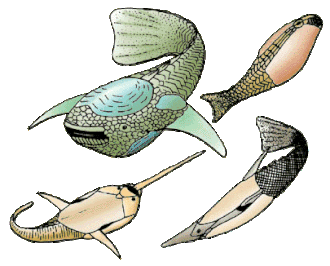
Anaspids were small armor less jawless fish. In fact, the name means “shield less ones”. They are covered in small, weakly mineralized scales and a row of large scutes running down the back. A major synapomorphy is the large tri-radiate spine behind the gill openings.
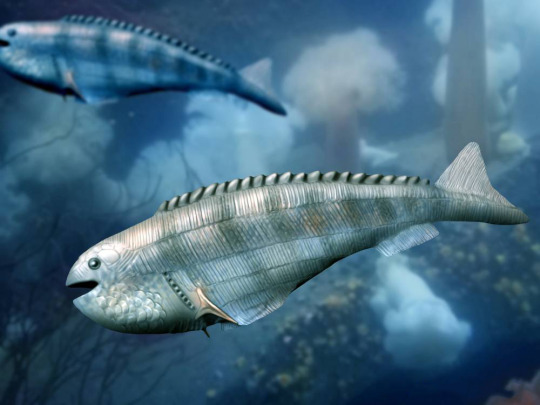
Osteostracans were the first group of fish with paired fins. They are often called ostracoderms, they were similar to lampreys in possessing two pairs of semicircular canals in the inner ear (as opposed to three in jawed vertebrates). These fish are the sister group to jawed fishes.
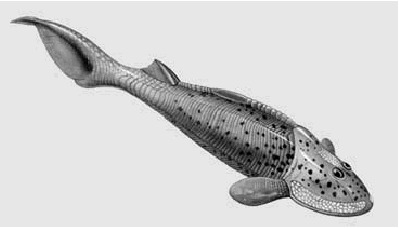
The jawed fishes first appeared in the Silurian Period. Four major groups radiated during this time: placoderms, acanthodians, cartilaginous fishes and bony fishes. Placoderms were mostly predatory armored fishes similar to the jawless ones. They were some of he earliest jawed fish and were the first ones to develop pelvic fins, the second set of paired fins. Some species have been found to be viviparous.
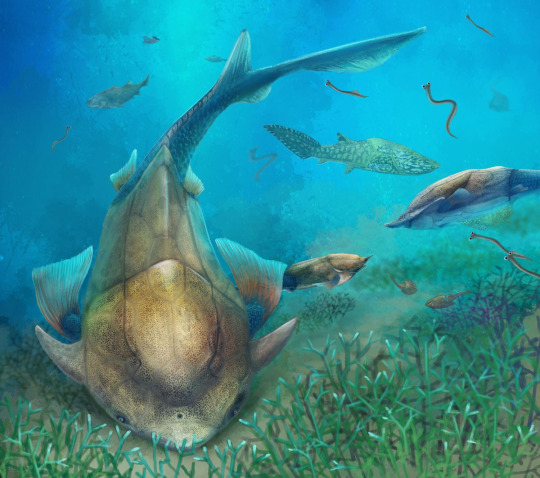
Acanthodians were small fishes with slender bodies. Th paired fins were modified to long spines earning then the nickname “spiny sharks”. Unlike most sharks, acanthodians lacked teeth. Many even moved to freshwater.
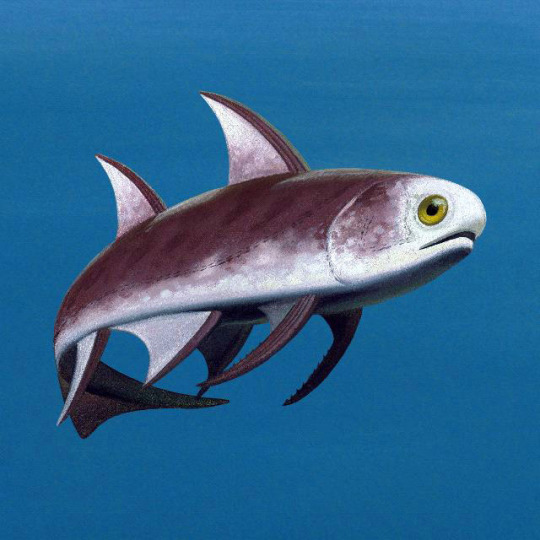
Chondrichthyes or cartilaginous fishesmay have evolved from acanthodians. This group consists of modern sharks, rays, skates and chimaeras.
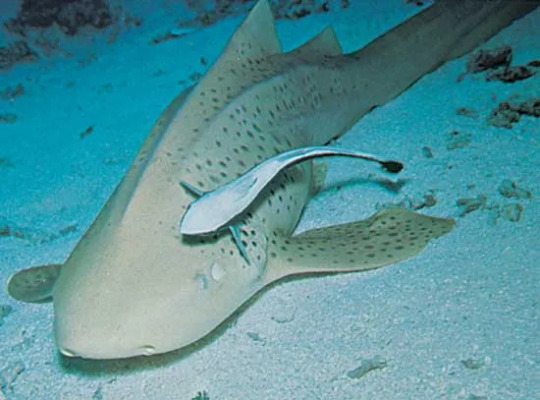
Finally, the first Osteichthyes or bony fishes appeared in the Silurian Period. Unlike all the other fish, they have an endoskeleton made of bone tissue.
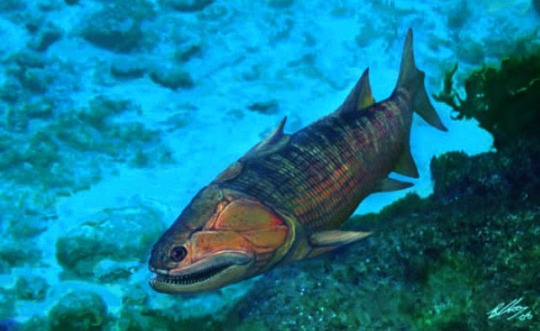
Thanks for coming to today’s lesson and tune in Monday to learn about the climate of the Silurian Period. Have a good weekend and fossilize you later!

#paleontology#fossils#science education#science#silurian#fossil friday#jawless fish#prehistoric fish#jawed fish
20 notes
·
View notes
Note
Say TT, what would be your top 10 T-rexes from media?
Ooo, tough one. I don't know if I can even rank them - I think I'll just share ten I love.
youtube
We'll start with the queen, the goddess, my inspiration, the T.rex(es) from Jurassic Park (and its sequels). An elegant design with so many iconic features, from the angry eyebrows to the overbite and of course the iconic roar. The franchise itself stops treating the T.rex with respect from the third movie on, but that doesn't stop it from being its flagship creature.
youtube
As villainous rexes go, I don't think any have surpassed that bastard Sharp Tooth, who channels the raw horror of the most fearsome fighting animal in the fossil record.
youtube
Every single moment of the T.rexes in Prehistoric Planet filled me with delight and childlike wonder - yes, even when one got chased away my quetzalcoatluses. It was just nice to see a dino documentary where T.rex doesn't die for once, and seeing rexes be tender and social was also something I deeply crave but rarely get to see in dinosaur media.
youtube
For dino documentaries that break my heart, the Walking With Dinosaurs rex reigns supreme. I know it's not a particularly accurate reconstruction (and in fact kind of mind bogglingly weird if you look at the details closely - what is going on with the area where her skull meets her neck?), but the story they tell with the rexes here is so tragic that it's burned into my mind. There's the one scene of a rex howling alone in the forest in search of a mate, where the narration notes that it's unlikely anyone will answer the call, that's just lodged into my memory as the ultimate illustration of romance-based loneliness. I feel that rex, man. I feel that howl into the empty woods.
youtube
I know it's not a "good" movie, but fuck it, I love The Last Dinosaur. I love the suitamation, I love how the T.rex is presented as this borderline supernatural threat in the vein of Moby Dick, I love that it actually gives us a T.rex vs. Triceratops fight (an odd rarity in dinosaur media despite it being a matchup that 1. happened a LOT in reality and 2. pits two of the most popular and fearsome dinosaurs against each other - "T.rex vs. Triceratops" is, like, someone who's so hot that no one ever asks them out because they think they have no chance).
youtube
There's a Japanese kid's movie about a girl who's trying to reconnect with her estranged paleontologist mother and ends up adopting a baby T.rex, and it's very cute and deeply emotional and has scenes of a baby T.rex in a Christmas cape and Santa hat evading the Feds because that's just what you have to do when you're a weird animal companion to a child. It love it. It's called Rex: A Dinosaur Story and I watch it illegally every year because there's no US release of it.
youtube
You Are Umasou is another Japanese piece of paleomedia aimed at children with a deeply emotional story about strained parent-child relationships that involves a T.rex - several T.rexes, actual, one of which invents the art of kickboxing to style over his opponents - and l also used to watch it illegally, but luckily Discotek Media released a blu-ray collection of it and its sequels (called "The Heart and Yummie Collection" in an atttempt to translate the pun of the original title that only kinda works), so now I can just watch it whenever, to my delight.
youtube
Fang from Primal is one of the most well-rounded T.rex characters in media and I love her so much, even if I can't watch the first episode of that show ever again. It's a shame that show never got a second season, I would have loved to see more of Fang's adventures in a prehistoric world full of dinosaurs and monsters. A damn shame that they didn't continue it - they certainly wouldn't have made the show be about ancient human civilizations with almost no monsters and a weird scene where a woman sleeps with a caveman covered in third degree burns.
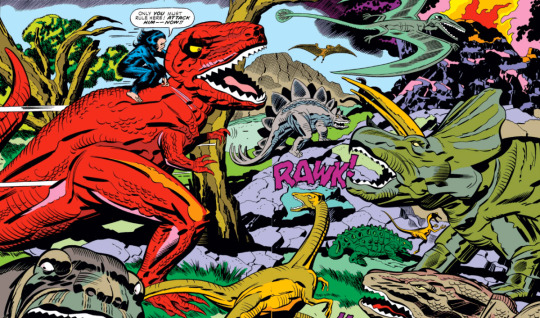
Speaking of tyrannosaurs who get a great deal of characterization and team up with cavemen to fight dinosaurs and monsters in a fantastical prehistoric world, none have ever done it better than the original Devil Dinosaur. He lost all of that characterization and, like, any agency at all really when Jack Kirby stopped writing him, sadly, but at least he had a fun team up with Godzilla before he was reduced to a mindless brute and/or glorified pet in subsequent Marvel stories.

Finally we end with Gon, the star of the manga of the same name, a tiny little T.rex (well, arguments could be made he's more of a generic theropod, but he's been called a T.rex enough for me to count him here) whose anthology series tells some of the most dramatic, emotional stories about animals surviving in the harshness of nature without a single line of dialogue. Gon's stories range from the humorous to the downright tragic, and you can always tell what this little dinosaurs is thinking and feeling without him saying a goddamn word. Also he personally beat the shit out of every single fighter in Tekken, which basically makes him as powerful as twenty Gokus.
36 notes
·
View notes
Text
Thinking about Rain going to so many aquariums on his first time touring. The ghouls always loved sight seeing in new cities on days off from performing, but Rain spent so much of his time in aquariums. Elbows deep in a touch tank for 20 minutes because he wants to pet every single butterfly ray and shovelnose guitarfish at least once. Before touring, he had asked the retired ghouls if they wanted souvenirs or what their favorite animal was. Many declined his offer of souvenirs, not wanting the young ghoul to spend their allowance on them. But he still bought them little touristy things, shot glasses, fridge magnets, stickers, t-shirts.
One afternoon Mountain drags him to a gem show because they heard there would be fossils and shark teeth, something right up the water ghoul's alley. Rain spent over an hour marveling at a table of shark teeth, searching for one of a specific species. The young water ghoul had bonded with Mist over their shared love of sharks, he wanted to find her the best souvenir imaginable.
When the ghouls returned home at the end of tour, Rain began to make his rounds to his pack with souvenirs bought for them. He had purchased every pack member little glass figurines of their favorite animals, Dewdrop having the biggest reaction. The fire ghoul literally leaping into Rain's arms over the small glass spotted eagle ray. It took 20 minutes to pry Dew from his arms, who was profusely thanking him for the figurine that would reside on his bedside table for the rest of time.
But Rain was more excited to visit Mist, the find he had made at that gem show had him on edge as he walked into the den of the retired ghouls. He found her in her room, the door open and her head in an old marine biology textbook. One that she had used to teach Rain about certain species of sharks.
Rain cleared his throat, watching her head snap up and in his direction. The ghoulette half expected Alpha to be standing in the doorway, the fire ghoul had a tendency to loom until he was noticed or was forced to make his presence known. "Rain my sweet! You're home" she said, moving the textbook off her lap and motioning for the ghoul to enter.
"I brought you a souvenir," Rain said, entering the room with his hands behind his back "I know it's not much but I couldn't pass it up."
Mist rose from her bed, meeting the ghoul in the middle. "You didn't have to do anything for me sweet, I wanted you to spend your money on you and enjoy your time" she said gently, studying his features.
Rain shook his head, "I know I didn't have to, I just saw it at a gem show Mounty dragged me to and I had to get it for you."
At that moment a small golden box was placed in the ghoulette's hands, a wordless invitation to open the gift. The pair stood in silence as Mist untied the bow that was carefully knotted around the box, time seemingly standing still to Rain who was teeming with excitement. The lid of the box was lifted off slowly before being slammed back on.
"Rain you did not" she said, the surprise evident on her face. She opened the box once more before taking the object into her hand gently, not wanting to break it.
"But I did" he said, the smile plastering his face evident in his words. "I spent an hour at this one booth searching for a lemon shark tooth, I knew there had to be one there."
Mist placed the tooth back in the box, placing it on the edge of the alter in her room mistakenly. The motion was quick and unintentional, as all she wanted was to get her arms around her young water ghoul. "Rain it's perfect, you truly didn't have to do that" she spoke, her voice heavy with the tears brimming in her eyes.
The water ghoul wrapped her in a tigh hug, this was the exact reaction he expected. Aside from the tooth becoming a permanent piece of her alter, that was unexpected part for both of the ghouls.
"I remembered what their teeth looked like, from that textbook you had shown me. I knew it was your favorite shark and I just had to find one." He spoke softly, the ghoulette looking up to him. The pride in her was almost tangible, for the knowledge bestowed upon her protégé coming into good use.
As the hug broke apart, the pair looked toward the box teetering on the edge of her alter. "Well, looks like Lord Lucifer gets a shark tooth" Mist laughed, wiping the stray tears from her eyes.
"Seems like he enjoys the offering, or at least the box it's in" he laughed, the golden box was seemingly a fan favorite.
28 notes
·
View notes
Text
Warrior Cats Prefixes List- A
I had a WC Name Generator on Perchance that I made but I don't seem to have access anymore, so I'm remaking it here as just a simple list. The definitions used are the ones that Clan cats have for those things, and thus are the origins of the names. Definitions used are whatever I found when I googled it.
Acorn-: "[noun] the fruit of the oak tree, a smooth oval nut in a rough cup-shaped base"
Adder-: "[noun] a small venomous Eurasian snake that has a dark zigzag pattern on its back"
Agaric-: "[noun] a fungus with a fruiting body that resembles the ordinary mushroom, having a convex or flattened cap with gills on the underside"
Agate-: "[noun] an ornamental stone consisting of a hard variety of chalcedony, typically banded in appearance"
Albatross-: "[noun] a very large oceanic bird related to the shearwaters, with long narrow wings"
Alder-: "[noun] a widely distributed tree of the birch family which has toothed leaves and bears male catkins and woody female cones"
Algae-: "[noun] a simple, nonflowering, and typically aquatic plant"
Allium-: "[noun] a bulbous plant of a genus that includes the onion and its relatives; [noun] flowers growing 4 or 5 feet tall with white, blue, lavender or purple snowball-shaped inflorescences atop bare stems"
Almond-: "[noun] the oval edible nutlike seed of the almond tree, growing in a woody shell; [noun] the tree that produces almonds"
Aloe-: "[noun] a succulent plant, typically having a rosette of toothed fleshy leaves and bell-shaped or tubular flowers on long stems"
Alpine-: "[adj] relating to high mountains; [noun] a plant native to mountain districts; [noun] a butterfly with brownish-black wings and red-orange spots"
Amanita-: "[noun] any of various mostly poisonous fungi with white spores and a globe-shaped swelling about the base of the stem"
Amaryllis-: "[noun] a bulbous plant with white, pink, or red flowers and strap-shaped leaves"
Amber-: "[adj] golden yellow in color; [noun] a honey-yellow color typical of amber; [noun] hard translucent fossilized resin produced by extinct coniferous trees of the Tertiary period, typically yellowish in color"
Amethyst-: "[noun] a precious stone consisting of a violet or purple variety of quartz; [noun] a violet or purple color"
Anemone-: "[noun] a plant of the buttercup family, typically bearing brightly colored flowers"
Ant-: "[noun] a small insect, often with a sting, that usually lives in a complex social colony"
Antler-: "[noun] each of the branched horns on the head of an adult deer (typically a male one), which are made of bone and are grown and cast annually"
Aphid-: "[noun] a minute bug that feeds by sucking sap from plants"
Apple-: "[noun] the round fruit of a tree of the rose family, which typically has thin red or green skin and crisp flesh; [noun] the tree which bears apples"
Apricot-: "[noun] a juicy, soft fruit, resembling a small peach, of an orange-yellow color; [noun] the tree bearing apricots"
Arch-: "[verb] to have or take on a curved shape"
Argus-: "[noun] a small brown or bluish Eurasian butterfly that typically has eye-like markings near the wing margins"
Ash-: "[noun] the powdery residue left after the burning of a substance; [noun] a tree with silver-gray bark"
Ashen-: "[adj] the pale gray color of ash"
Aspen-: "[noun] a poplar tree with rounded, long-stalked, and typically coarsely toothed leaves"
Asphodel-: "[noun] a Eurasian plant of the lily family, typically having long slender leaves and flowers borne on a spike"
Aster-: "[noun] a plant of the daisy family that has bright rayed flowers, typically of purple or pink"
Auburn-: "[adj] of a reddish-brown color; [noun] a reddish-brown color"
Arum-: "[noun] any of a genus (Arum of the family Araceae, the arum family) of Eurasian plants having usually arrow-shaped leaves and a showy spathe partially enclosing a spadix"
Avalanche-: "[noun] a mass of snow, ice, and rocks falling rapidly down a mountainside"
Avocet-: "[noun] a long-legged wading bird with a slender upturned bill and strikingly patterned plumage"
Azalea-: "[noun] a deciduous flowering shrub of the heath family with clusters of brightly colored, sometimes fragrant flowers"
Azure-: "[adj] bright blue in color; [noun] a bright blue color"
#sorry for the lack of content recently#I still haven't gotten any of my ADHD meds so I'm going to post what I can for now#I also have a post coming out on halloween that I wrote like a year ago#warrior cats#warrior cats rewrite#worldbuilding
5 notes
·
View notes
Text
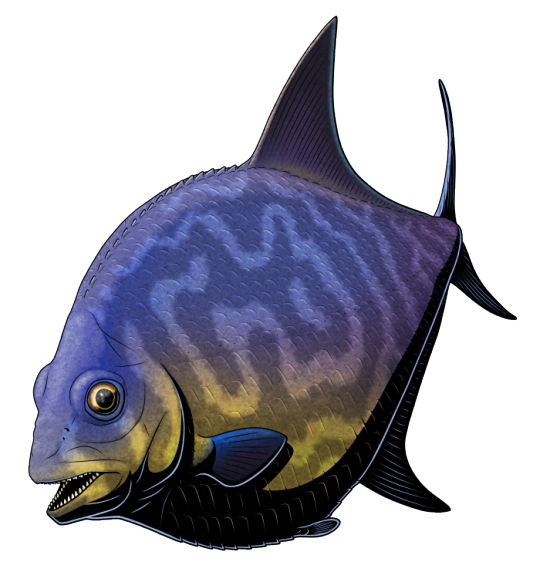
The pycnodonts were a diverse group of ray-finned fish that were found in shallow coastal waters from the late Triassic to the late Eocene (~215-37 million years ago). They usually had deep but very narrow body shapes with a disc-like appearance, convergently similar to modern reef fish like marine angelfish or butterflyfish – but some looked much weirder, with elaborate horns and spines, long snouts, or vertically-stretched bodies.
Most of them also had jaws full of round flat teeth used to crush hard-shelled prey, but some may instead have been herbivorous grazers similar to parrotfish.
And a couple of lineages even became carnivores.
Serrasalmimus secans lived in what is now Morocco during the late Paleocene, about 59 million years ago. Although only known from its jaws, the size of the fossil material suggests it was fairly large for a pycnodont, possibly around 80cm long (~2'8").
It had sharp flesh-cutting teeth similar to those of modern piranha, but with a surprising evolutionary twist. Unlike any other known ray-finned fish, Serrasalmimus' teeth were true shearing carnassials anchored into bony sockets, with new replacement teeth forming directly below each current tooth – a very specific arrangement of features previously only known in mammals.
This is an especially remarkable example of convergent evolution because on land placental carnivorans were developing their own carnassials at the same time, just a few million years after the K-Pg mass extinction. Both mammals and pycnodonts were simultaneously taking advantage of the vacant predatory roles in their respective ecosystems, and ended up with incredibly similar tooth adaptations as a result.
———
Nix Illustration | Tumblr | Twitter | Patreon
#science illustration#paleontology#paleoart#palaeoblr#serrasalmimus#serrasalmimidae#pycnodonts#pycnodontiformes#neopterygii#actinopterygii#fish#art#convergent evolution#swim like a butterflyfish bite like a mammal
243 notes
·
View notes
Text
Shark tooth Pattern fossil
While watching FroggyCrossing’s most recent 30 day challenge using no items it came to my attention that people might not understand the shark tooth pattern that they are showing on the fossil, and while Blather’s can try to explain it, nothing really does as good of a job as just showing you the crazy extinct animal as geologists/paleontologists think it was.

Yes folks, this is helicoprion. Initially, you might look at it and say, “I am not shocked it went extinct its mouth makes no sense!” however, I would like to remind you that current existing ray/sharks that are currently alive are just as extra and ridiculous.
such as:
Sawfish

Frilled Shark
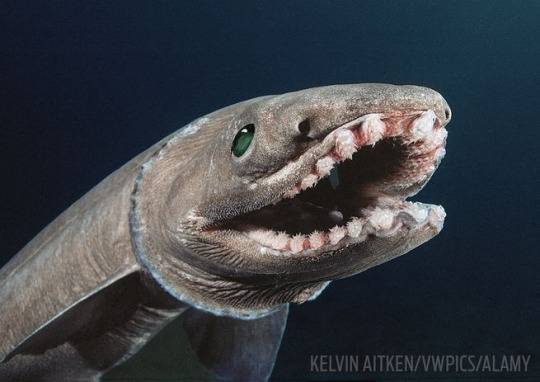
Goblin Shark
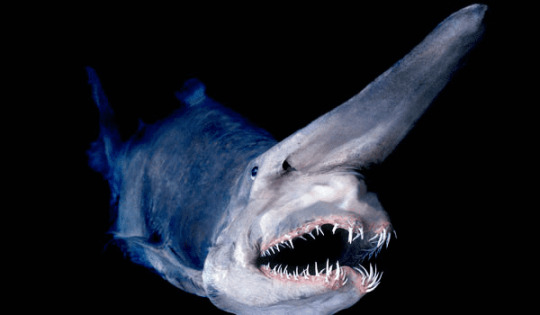
and maybe the most handsome, but the most well known, the Hammerhead
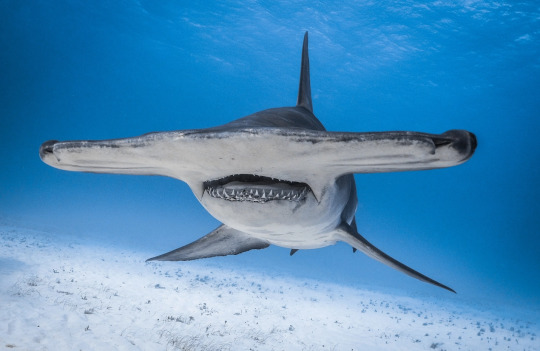
and their less well known cousin, the bonnet head
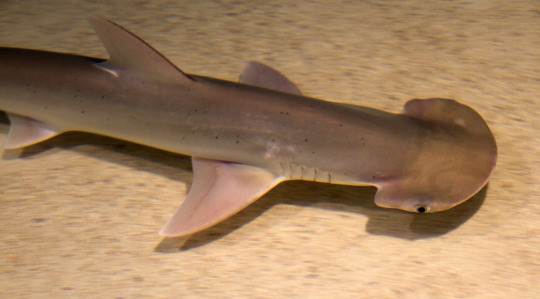
Long story short, Sharks are old as hell, they have been on earth for 450 million years, not only is that way older than the dinosaurs, but they are also older than trees!
23 notes
·
View notes
Photo

RARE Miocene Ray Tooth Fossil | S'Algar, Menorca | Authentic Prehistoric Marine Specimen | Certified Fossil | Collectible Fossilized Tooth
Discover a Rare Ray Tooth Fossil from the Miocene epoch, unearthed in S'Algar, Menorca. This beautifully preserved fossil offers a glimpse into the marine life that thrived around 15 million years ago. Menorca’s fossil-rich formations provide some of the finest examples of prehistoric marine life, making this an exceptional addition to any fossil collection.
Rays, known for their cartilaginous skeletons and specialized dental plates, used their teeth to crush and grind shellfish and crustaceans. This rare specimen highlights the intricate details of the tooth structure, making it a valuable educational and display piece.
Fossil Information:
Species: Prehistoric Ray (Exact species undetermined)
Fossil Type: Single Tooth
Geological Formation: Miocene Deposits
Age: ~15 million years old (Miocene Epoch)
Location: S'Algar, Menorca
Size: Full sizing provided in photos (Scale: 1cm per square)
Preservation: Excellent, showing distinct dental features
Key Features:
✔ Authentic Miocene Ray Tooth Fossil
✔ Sourced from the fossil-rich region of Menorca
✔ Well-preserved with natural dental structures
✔ Ideal for collectors, museum displays, and educational use
Authenticity & Certification:
All of our fossils are 100% genuine specimens and come with a Certificate of Authenticity. The fossil shown in the photos is the exact specimen you will receive.
Why Buy From Us?
This Ray Tooth fossil comes from the prestigious Alice Purnell Collection, one of the largest and most respected fossil collections in the world. We specialize in high-quality, museum-grade fossils, ideal for serious collectors, educators, and researchers.
🦈 Own a rare piece of Miocene marine history today—add this Ray Tooth fossil to your collection!
#Ray Tooth Fossil#Miocene Fossil#Menorca Fossil#Prehistoric Marine Fossil#Fossilized Ray Tooth#Certified Fossil#Authentic Fossil#Fossil Collector Item#Marine Life Fossil#Fossil Tooth Collection#Fossil from Spain#Fossil Gift#Rare Fossils for Sale#Shark and Ray Fossils#Miocene Marine Fossil
0 notes
Note
I heard you have a favorite fish. Info dump to me about your favorite fish
Well my dear anon, sit back and relax while I show you my favorite creatures
First up we got Sea Jellies. My favorite one is the moon jelly since it has bioluminescence and literally anything bioluminescent is my favorite thing ever. They start out as teeny tiny little polyps that eventually sprout into baby jellies and go on to live their lives no thoughts full of vibes ✨ Jellies literally don't have a brain, just a basic nervous system and rely on ocean currents to carry them around. Moon jellies in particular can grow to be 20+ inches wide and are considered one of the most harmless types as their stingers aren't long enough to penetrate skin.

Next up we have the Royal Gramma aka the Fairy Basslet. The reason for their name is for the royal purple that covers half of their body while their tail fin is a golden yellow. They're kept in aquariums and are native to coral reefs in the Atlantic Ocean. The reason why I love them so much is that they're transgender in my heart. When there's a shortage of female fish, the males will literally change their genetic makeup in order to help continue their population. (they're just like me fr fr) this phenomenon isn't exclusive to their species, though, there are other fish and some amphibians who do the same!
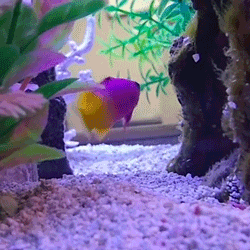
You wanna talk about molluscs? Cause we're gonna talk about molluscs. One super cool one that I love very much is the nautilus. They're part of the cephalopod family (squid, octopi and cuttlefish) and are a species that haven't changed very much in terms of evolution aside from getting smaller, likely due to there being less oxygen in the ocean than back in prehistoric times. They're a cephalopod that lives in a shell, you've likely seen spiral shell fossils of the bigger ancestors before in museums! They're very cool, I based a drawing I did of Cthulhu off of one once back in my design class at college. The pokemon Omanyte is based off of them!

Speaking of cephalopods: squid!!!!!! Squid 💜💜💜 oh my fucking god I love squid and octopi so much. My top 2 squid are the firefly squid snd the vampire squid. Both are species that live in the deeper ocean, known as the Twilight level. It's not quite as deep as the abysal zone (where all the super cool kids hang out) but it's still deep enough where not a whole lot of sunlight gets to. The firefly squid is near and dear to my heart because they also have bioluminescence! They flash an array of colors and depending on the color and rate of flashes, it's said you can tell their emotions! Squid and octopi are both highly intelligent creatures and need a lot of enrichment or else they'll get bored and sad (just like me). The cutest thing about firefly squid is that they're one of the smallest species of squid, growing to be about 3 inches long at most!!! Their bodies aren't the only thing that glow, their ink glows as well! In the usual ocean levels, cephalopods squirt out a black ink to ward off predators but not the firefly! Because the Twilight level is so dark, predators are used to it so squirting black ink would do nothing. However, glowing ink will stun a predator long enough for the little guy to swim away. I wanna be a firefly squid in my next life.

The Vampire squid is another very small squid, they're deep red, and their tentacles have webbing inbetween like a bat! Hence the name. Instead of squirting ink like a regular squid would do, however, they fold their head into their tentacles which have tooth like barbs on the inside. Truly a metal species if you ask me. I'm gonna give them a littol kiss. They also got cute little ear flippers 💜💜
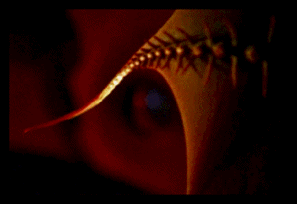
We talked about bony fish. We talked about molluscs. Now it's time for cartligenous fish! (my beloved) in the cartligenous fish family we got sharks, rays, and skates. There are so many sharks to talk about, so little time. I love them all, you hear me? Every one of them. I don't even know where to start. Maybe I'll do some general info <3
Sharks, as we know, are very misunderstood and while sometimes friendly, they're better to admire from a distance. They help keep fish and seals from overpopulating and are very important to keeping the ecosystem healthy. There's a common misconception that all sharks need to swim in order to breathe. In reality that's only mostly true for ram ventilators. Ram ventilating sharks are the kinds of sharks that people usually think of like the great white, whale shark (my love), and tiger shark. However! Not all sharks need this! There are some species of less active sharks like the nurse shark and the leopard shark (the smallest boy) that breathe through a process called buccal pumping which means they draw water into their mouth and force it to pass over their gills. This allows them to rest on the ocean floor. Sharks like the nurse shark are generally pretty docile and sometimes even allow people to pet them 💜
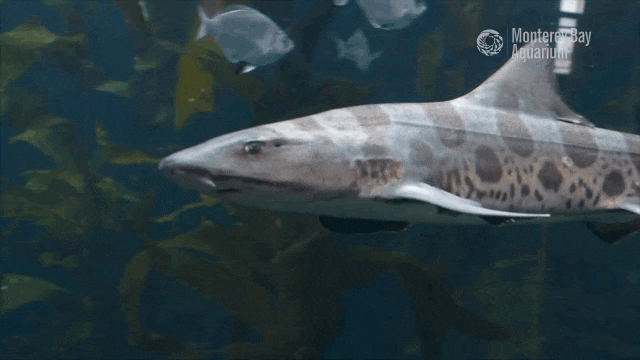
Look at that little guy go
2 notes
·
View notes
Text
Goodbye little Elk
https://www.youtube.com/watch?v=pYzWmKlZtrU&ab_channel=nova60
At first glance this panicked creature may look like a fully grown Cervitaur of a Caribou, and it may appear that he has an antler deformity causing his antlers droop down to the sides of his head. But this is not the case, this is in fact this is an adolescent Irish Elk Cervitaur with a scientific name of ‘Megaloceros giganteus Elaphocentaur’. His future fossil records suggest that he is around the age of 15 to 16, and that he lived approximately 8000 years ago. This specific individual also appears to have some form of hyperpigmentation disorder on his lower half, causing the normally brown fur of the species to appear black. This young bull has been separated from his herd and has been searching for it for the last several hours. But little does he know his search is about to come to an end in the worst way possible.
Danny was well aware that he was a dumbass, his sister would constantly remind him of this fact. Of course it was all in good fun. “MOOOHEEEEEUHHMmmm” He called out to his mother knowing that his shrill cry out to her would carry for miles. While keeping an even paced trot, he scanned the foggy horizon of the chilly morning dew fields for her and his sister. Tears began threatening formation, he had at this all night and there hadn't even been a response call back. His self-hug tightened in on himself as he slowed to a stop, the tidal wave of emotions and realizations that he had been holding back we're starting to crack the dam.
The tears that now fell freely down his face were much warmer than the chilly air, a dry heave came up through his throat as the conclusion that he had been ignoring for the last several hours finally reared it's ugly head. He was alone, completely and utterly alone. He had no idea where his herd was and they had no idea were he was. For all they new he could be being eaten by a saber tooth right now. He knows how dangerous it is to stray from the heard, his antlers aren't even two feet long yet so why the hell did he wander.
His ears shot back on a swivel point and he froze as he was pulled back into reality, he had heard something out there. Slowly he turned himself around to point in the direction of the sound and flicked his ears forward straining them to pick up the smallest sounds. There out in fog was a small movement.
Danny took a step forward leaning his human body forward and subconsciously extending his opposite back leg out to balance his already tremendous weight. Danny squinted and placed his hand above his eyes to block out what ever early morning rays were able to creep through the overcast sky. He sat there staring out over the land for a moment or two try to see if he could spot what ever was out there.
The wind picked up and blew in his direction just as he was beginning to abandon his side search and a familiar sent slammed into him. His eyes widened in recognition and his ears dropped down to the side of his head. He could practically hear his own heart begin to palpitate in his chest. “No, no no no no” A loud howl erupted a good ways away the source of it being shrouded by the fog. A pack of dire wolves was approaching him.
Danny stumbled backwards away from the smell as he began to hyperventilate, he stumbled over his own four feet as he turned around to flee. The thunderous sound of his hooves slamming into the dampened dirt cut through the other wise quiet and serene landscape. The beat of his hooves hitting the floor alongside his heavy breaths that were laced with fear created a harmonious rhythm that was only interrupted with splashing as he ran through what he believed to be a shallow pool from the other days rain.
Danny’s pace was slowed significantly once he entered the pool, he internally cursed himself for not just going around the shallow puddle. Although the puddle was much shallower than he originally believed it to be and the ground was much softer in the dirt in the surrounding area. Perhaps the water pulled above it combined with how hot it was the day before had made the ground soggier.
Danny’s heart felt like he had just jumped from a cliff with realization.
A Tar pit.
He was stuck in a tar pit. “OHH GOD” he yelled out. “SHIT” He leaned his upper half forwards with one of his front hooves in an attempt to move himself out of the tar. He may have succeeded if he pulled up out of the tar and then moved it forward, but fear clouded his judgment and the offset caused him to tilt forward and land sternum first into the tar. Danny lay on his human stomach and his deer rear facing skyward, his arms spread out in front of him in an attempt to keep his head off of the tar. He could feel his back hooves slowly sliding away from him, in a split second before another wave panic struck him, he wondered if his legs would slide out from under him or if they would buckle under his weight first.
His question was answered for him as a squelching sound from his hooves sliding through the tar reached his fuzzy ears. And in the moment that his hindquarters landed on the tar he attempted to push himself up with his front legs, only to feel them sink deeper into the pit. He cried out in shock as this happened, although the new position removed some pressure off his neck, which not only had to hold up his head but as well as his antlers that reached a little over 5 feet from tip to tip. And he knew as soon as he put his head down the underside of his antlers would become stuck in the tar, if that were to happen it would become impossible to remove his head and seeing that in this position, he was barely able to hold his head up let alone put out of the sticky oil what spell disaster for his already doomed self.
Danny breathed in deeply in an attempt to calm himself before taking a moment to collect himself to pull all of the emotion that he had been feeling throughout the day to place it on a back burner. His sister had always told him that if he got himself into danger, he needed to be able to think clearly. So he took another deep shaky breath before starting the grounding exercise she had taught him to do. So he sat there in tar quietly feeling the sticky tar cover his under belly, the tar itself smelt like shit. It also felt like shit in his fur.
The smell reminded him of the onetime his sister dared him to stomp on an abandoned terror bird nest. He felt warm rays of the sun as they begin to peek through the clouds is it ascended into the sky. Feeling calm enough he decided to attempt his stand once again, the sense of calm but he had managed was quickly overshadowed by fear and dread as sudden shift in weight began to pull him further into the pit of crude oil.
He began to panic and pulled his top half off of tar a sudden boost in strength given to him bye fear, that new weight combined with his panicked flailing pulled his legs even further under. “MOOOHEEEEEAAAAAEEEEUUUHHMmmmmmm” He struggled and cried out again for his mother, panic filling his voice. He cried out for her again and again only stopping when the winds sudden change in direction reminded him that he was not alone.
His ears flipped back and his eyes widened at the sound of large paw pads slamming against the earth. At this point his level of panic had reached its Max and he could do nothing but watch as the dire wolves walk carefully around the edges of the puddle searching for the piece of land that had the shortest distance to him. one of the younger possibly less experienced wolves paced impatiently as its elders searched for a good entrance point.
Several of the rougher looking wolves had already decided that they were to wait until he tire or pass out for exhaustion, they let him know this by going and laying under some underbrush nearby not once taking their eyes off him. The majority of the wolves however, continued to sniff along the edges of the bank gauging the distance between himself and the edges of solid ground. The younger impatient wolf disappeared behind him out of Danny’s line of sight.
Then suddenly Danny feels a great force impact him from behind, the wolf has jumped onto his back. The sudden force from the impact sends his body down several inches more into the tar and the wolf begins to scratch and bite at his human back. Danny cries out in pain and through his hands over his head reaching desperately for the wolf. Danny in an attempt to reach back further he bends his upper half backwards and successfully manages to grab the wolf by its scruff. feeling the matted fur in between his fingers Danny throws himself forward, sending the wolf sailing overhead landing upside down in the tar. The force of the impact since the wolf down several inches into the thick oil and begins to whimper loudly as it realizes that it's back and entire face have been submerged in the tar. The force of him throwing the wolf over his head and into the tar cast himself to be slammed into the viscous black liquid and now he lays on his stomach his arms spread out in front of him to keep his head from landing in the tar.
It has been several hours since he has sent the wolf flying overhead, since then the wolf has stopped moving completely. The sun is now completely overhead it's heat evaporated bear entirety of the puddle that hid the tar pit from view. Danny lay miserably in the slowly heating tar as it radiated heat and bubbles slowly rising to the surface popped around him at random.
His throat was sore form calling out to his mother and he was beginning to feel lightheaded from the intense heat and the amount of water that he had lost and crying. One of the elder wolves stood up and began to slowly make its way over to the edge of the solid ground. Danny let out a single self-pity filled chuckle as he eyed the wolf. his neck and arms felt as if they were on fire he had never needed to hold up is heavy head like this for so long.
His arms had begun to tremble a while ago and he could feel the muscles giving out underneath him. And just like that his arms buckled from the weight of his own antlers, he wondered to himself how much longer would he have lasted if he did not have them. And with a resounding splat he landed in to the tar, he miraculously managed to keep his chin above the tar as it fell. Danny tilted his head to the side and allowed his antler to touch the tar, he was not going to be getting up from this anyways, so it didn't matter now. His eyes slid shut as he began to pass out from exhaustion the only sound now was of the wolves getting ready to feast on him.
#Elk#irish elk#Danny Phantom#danny fenton#cervitaur danny#cervitaur#centaur#extinct species Danny#extinct species#extinct species of center#extinct species of Cervitaur#tar pits#If the link does not work just look up elk screaming
26 notes
·
View notes
Note
Is there anything you want to info dump about right now?
WELL nothing in Specific but i've been thinking about marine biology lately and here's some Fun Facts that i can remember off of the top of my head - sharks don't have skeletons, they're basically all cartilage (like the stuff your ears are made of!) and the only thing thats able to be fossilized are their jaws and teeth. (fun fact: i went into a cave a few months ago and there was a super old shark tooth jutting out of the ceiling! the ceiling of that cavern was full of old seashells and stuff) - continuing on the shark thing: megalodon is NOT roaming around the oceans in modern day, megalodon died out about 3.2 million years ago and all its old territory is on land now. no it's not eating orcas, orcas are apex predators and are top of the food chain where they live. they eat moose!!! ORCAS ARE NATURAL PREDATORS OF MOOSE!!!! - i love orcas so much have i mentioned that? they're also called killer whales, and theres a bunch of different Kinds of orca. each orca pod is led by the grandmother, who teaches the calves (a baby orca is a calf) how to hunt and do Orca Things and each pod specializes in Certain Kinds Of Prey. they don't attack or hunt anything else! - going back to sharks: rays and sharks are related! rays are. literally just flattened out sharks - the goblin shark is what's known as a "living fossil", it's the only living member of the shark family Mitsukurinidae. it's a very rare deep-sea shark and also it's pink and also its HUGE
#i'll reign myself in#i could go on and on about marine biology#i'll continue if anyone wants me to JLKFSDJKFLDS#not stim#peachypupp#asks#marine biology rambles
6 notes
·
View notes
Photo
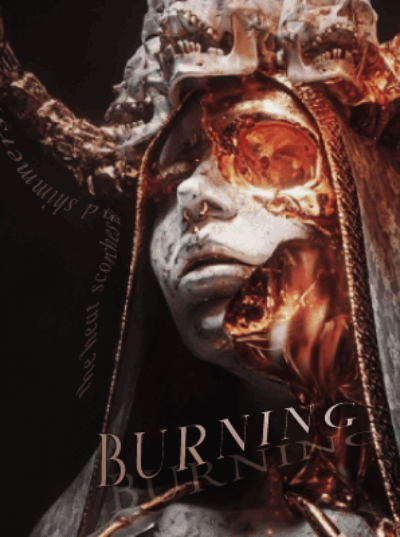
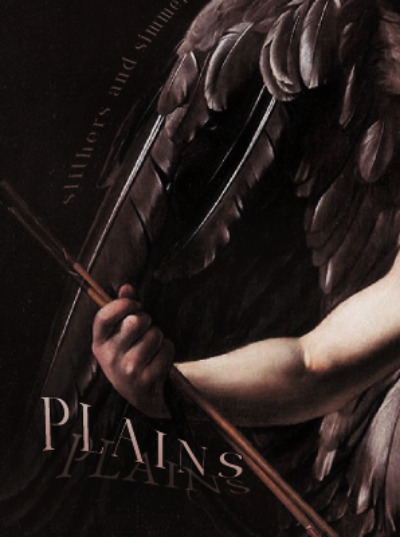
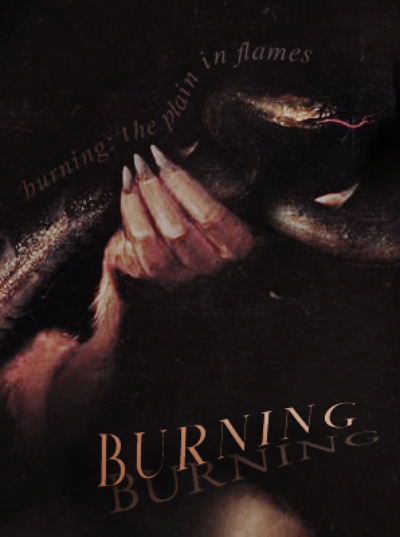
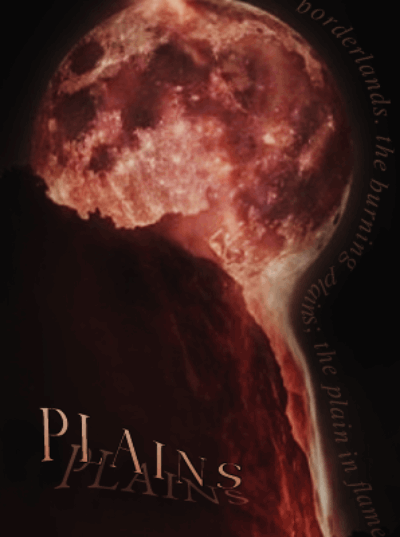
Pick one important location in your story and write a longer description of it from one of your character’s perspectives.
probably will be easier to read on my sideblog { here } due to font issues in my main. w/ @artless-whimsy

[THE BURNING PLAINS.]
“How does anything live here?" one of the angels asks, squinting up against cutting rays of harsh sunshine, golden and bright - so, so, bright, and burning jagged shards of glass-sharp light and smothering heat into every grain of sand, every molecule of air, coiling tightly into flesh and fur alike and choking out all the moisture.
“In the darkness," Mai says simply, recalling long-eared jackrabbits, burrowing kangaroo rats, cunning coyote kits; all the creatures that came out after nightfall, chittering and chattering and chirping. "And with the storms."
[SHADOW.] i. The sun hangs heavy in the sky, shining and still; the heat scorches and shimmers, slithers and simmers. There is no escape, save for the darkness.
ii. In the windswept desert, the golden light from above bleeds the earth dry and the sovereign in the clouds is nothing but a faraway dream. The creatures in this land of stinging sands and singed sunshine are wily and stubborn: they live, despite it all.
iii. Some call the Borderlands a wasteland, barren desolation seared over with dust and sand, but Mai would beg to differ. The kingdom in the clouds is bright with glory, gleaming with pearls and moonstone and otherworldly in its perfection. It is a realm that is more dream than reality, a land of blinding, brilliant divinity that glitters hard and sharp, like gemstones shattering over silk. But the kingdom above is no more alive than the smooth marble statues standing vigil over their sacred temples; nothing dies and nothing changes and there is no life, not in any way that matters.
Because: how can something have life, without death?
iv. Crawling centipedes and chuckling roadrunners and venom-dripped scorpions make a home in the Borderlands, where the light does nothing but burn, piercing straight to the bone. The flowers and birds and butterflies that meet the unforgiving heat and icy indifference of the desert with nothing but cleverness and cunning and an iron-forged determination to survive are more alive than anything from the kingdom above could ever hope to be.
v. Twilight falls over the hills, soft like ash; when the sun slips fully below the horizon, the night fills with chirps and cackles and snarls and screeches. Satin whispers and silken starlight murmur through the dust and shadows, and silvered moonglow shines out from behind the drifting clouds.
vi. In the Borderlands, the darkness is life. Anyone who does not know it now will come around, one way or another.

[SALVATION.] i. Dark clouds gather in the west, roiling and restless: they are bruises of dust and water vapor, blooming over the sky like deadly nightshade. Thunder growls over the land, a heaven-bound panther stalking its prey, and the mortals fear its wrath. Mai is not so foolish: in the desert, the swirling thunderclouds rumble with promises of rain and reprieve. It murmurs like a lullaby to her ears.
ii. The heat is stifling and silent. The air is dry as bone and poised like a hissing rattlesnake the moment before it strikes: all is quiet. All is still.
iii. The storm shatters the skies open as jagged daggers of lightning rend the world in two, furious and white-hot and roaring, incandescent like sunlight and starfire. Unrest rolls over the hills and chaos spirals across the desert. Mai feels it like singing steel piercing through velvet darkness, sending beams of silver-spun moonlight ricocheting into the night
iv. She breathes it in, lets it fill her veins. Chaos is power, and the demons are there when rain falls, when volcanoes erupt, when tectonic plates shift and collide. They bring the end of the world for an earthworm, a forest, an entire species, all so that angels can coax mud and mountain and life out of it all - because the angels are there when seedlings bloom into trees, when weeds and wildflowers wander into fire-struck desolation, when ash-green lichens and spring-soft mosses meander their way through the cracks and crevices of land scraped rock-barren by receding glaciers to begin anew. It’s a painstaking equilibrium between order and disorder, chaos and harmony, and the desert balances on the knife’s edge, dangling over the abyss. Here, the line between life and death is sharp and quick.
v. Sometimes, the storm-dark air is too dry, and the rain that glides downward with gravity mists away into nothingness before it ever has the chance to splatter clumsily across the ground. Lightning lances over the earth instead; it catches the tangled tinderbox of hardy desert shrubs on fire, and the blustery winds gusting across the hills only fan the flames higher.
vi. Other times, the rain falls doggedly toward the parched dirt, stubbornly defying the hissing heat and arid air and all the other forces of the universe that threaten to smother out every last bit of moisture. Then, all the desert rejoices.

[STARFALL.] i. The angel falls down, down, down in a radiant burst of glory-golden light: like sun-charred lightning striking the ground, or a meteor hurtling through the sky, bright and incandescent with molten mesosphere. The horizon lights up like a comet, and the moon is haloed in singing embers.
ii. A shock of celestial fury tears over the hills, setting all the desert alight in a rain of starfire. The flames that scorch the land are dying stars, shimmering with divine wrath: blazing, brilliant, and burning themselves to dust.
iii. The fire flashes and flickers over low-lying grasses and snarls of woody vegetation, devouring everything in its path as the air glimmers with heat and dances with ash. When it finally goes out, weeks later, there is angel-glass skidded in saw-toothed ribbons over the earth: ignited divinity and stinging sand fused into shimmering nuggets of pearlescent stone, the glory-gleam of paradise melded with the harsh, smoldering heat of the Borderlands. It glitters moon-pale and silver-searing under the darkness of the desert night
iv. Holy things burn demons, and angel-glass is no exception. Even so, Mai cannot bring herself to look away. She crouches down and closes gloved fingers around a small shard of the lustrous stone, running her thumb over the surface and feeling all the layered ridges and the bubbles of trapped air: breaths of lightning-charged atmosphere fossilized into eternity.
v. The wind swirls viciously around them, howling a sandstorm into ash-dark twilight. The angel’s eyes shine like falling stars under the scarlet-scorched light of the Gate; when she wraps an arm around Mai’s waist and presses a steadying hand into the bloodied shreds of ivory silk and ruffled star-shine clinging to her shoulders, Mai burns, molten divinity filling her veins and flooding through her un-beating heart. Wild desert marigolds and berry-sweet birds of paradise burst to life inside of her, drowning the hard steel and lancing moonlight of her ribcage in petaled brilliance.
vi. When their lips come together for the first time, the air hisses and crackles and catches on fire all around them, soft like morning dew and bright like sunbeams flaring over the stratosphere, setting mud and mountain and sky and sea ablaze in sparking flashes of gleaming gold and liquid amber.
Mai has never felt more alive.
15 notes
·
View notes